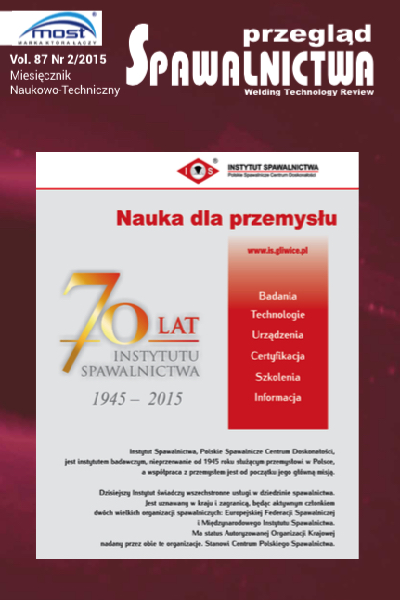Wykorzystanie klasycznego defektoskopu ultradźwiękowego do oceny połączeń zgrzewanych blach karoseryjnych
Main Article Content
Abstract
W pracy przedstawiono problematykę wykorzystania klasycznego defektoskopu ultradźwiękowego do badania i oceny połączeń zgrzewanych, wykorzystywanych w konstrukcji współczesnych pojazdów samochodowych. Ze względu na to, że same metody badania tych połączeń są znane, w pracy ograniczono się do oszacowania możliwości uzyskania impulsów ultradźwiękowych, zobrazowanych na ekranie defektoskopów, przydatnych do oceny połączeń podczas ich badań. Badania wykonano dwoma różnymi defektoskopami przeznaczonym do badania połączeń zgrzewanych i uniwersalnym. Wykonane pomiary pokazały, że jest możliwe badanie defektoskopem klasycznym połączeń zgrzewanych, jednakże w sytuacji prowadzenia częstych kontroli (np. w produkcji seryjnej) uzasadnione jest posiadanie defek- toskopu sepcjalistycznego.
The use of classical ultrasonic flaw detector to evaluation of resistance spot welds of car body sheet
Abstract
The paper presents the problem of use of classical ultrasonic flaw detector for testing and evaluation of welded joints which are used in the construction of modern motor vehicles. Due to the fact that methods to test the connections are known, this work is limited to the possibility of obtaining valid flaw signal on the screen of ultrasonic flaw detector research. The tests were performed with two different flaw detectors one dedicated to the study inseparable connection and second the classic flaw detector. The measurements had shown that it is possible to study welded joints by classic flaw detector, however, in case of conduct frequent inspections (eg. in mass production) is justified to buy dedicated flaw detector.
Downloads
Article Details
Creative Commons CC BY 4.0 https://creativecommons.org/licenses/by/4.0/
Welding Technology Review (WTR) articles are published open access under a CC BY licence (Creative Commons Attribution 4.0 International licence). The CC BY licence is the most open licence available and considered the industry 'gold standard' for open access; it is also preferred by many funders. This licence allows readers to copy and redistribute the material in any medium or format, and to alter, transform, or build upon the material, including for commercial use, providing the original author is credited.
References
Słania J., Kuk Ł.: Proces łączenia materiałów do budowy pojazdów i nadwozi w przemyśle samochodowym, Przegląd Spawalnictwa, nr 3, 2014.
Godek J., Senkara J.: Metodyka badań trwałości elektrod do zgrzewania oporowego punktowego z wykorzystaniem zmechanizowanego stanowiska pomiarowego, Przegląd Spawalnictwa, nr 6, 2014.
Kowalczyk J., Ulbrich D., Mańczak R.: Badanie połączeń zgrzewanych blach stalowych metodą ultradźwiękową, Przegląd Spawalnictwa, nr 6, 2014.
Kaminski R.: Ultrasonic Testing of Spot Welded Joints on Coated Steel Sheets and Optimization of Welding Parameters. Krautkramer. Spotweldtesting.com, 20.10.2013.
Buckley J., Servent R.: Improvements in Ultrasonic Inspection of Resistance Spot Welds. The 2nd International Conference on Technical Inspection and NDT (TINDT 2008). October 2008, Tehran, Iran.
Vural M., Akkus A.: The Ultrasonic Testing of the Spot Welded Different Steel Sheets. Journal of Achievements in Materials and Manufacturing Engineering. Vol. 18, September - October 2006.
Maev R., Chertov A., Regalado W., Karloff A., Lichaa P., Phan T.: Real Time Ultrasonic System for Resistance Spot Weld Inspection. Integration in Assembly Line. 4th International Candu In-service inspection and NDT in Canada. 1821 June 2012, Toronto, Canada.
